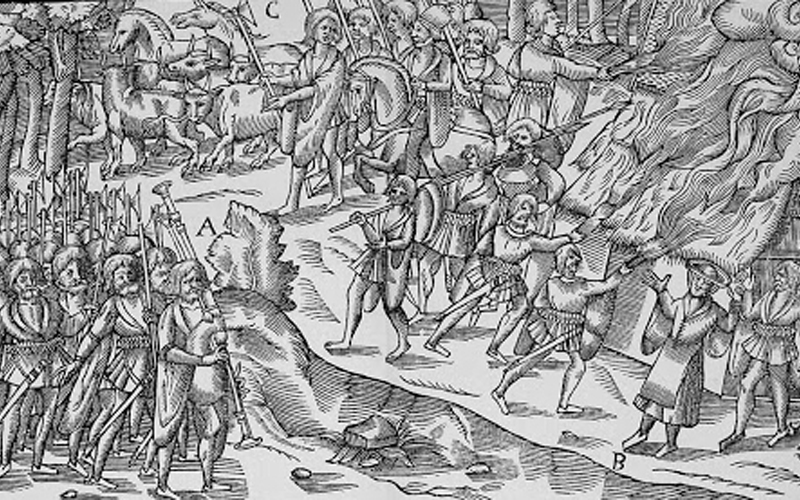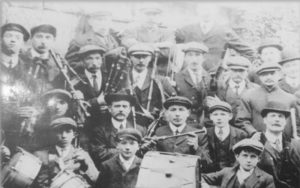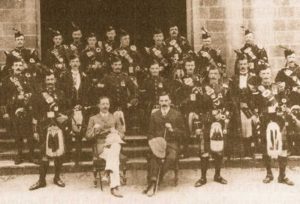‘The EARL OF DESMOND’S PIPER’:
A COUNTY KERRY TRADITION
by SEAN DONNELLY
The Desmond Rebellion, 1579-83, ended with the slaying of Gerald Fitzgerald, 14th earl of Desmond, at Glanageenty, near Tralee, Co. Kerry on 23rd. November 1583.The Earl’s extensive lands in the counties of Cork, Kerry and Limerick, were set out to English colonists in the Plantation of Munster (1586). Traditions of the last earl of Desmond lived on in his former lands. In 1883 people in Glanageenty showed the historian Richard Bagwell where he had been slain. A party of Moriarties actually killed the earl, and this deed was remembered to Moriarties in general until well into the nineteenth century, particularly by the Earl’s kinsmen, the Fitzgeralds, Knights of Glin.
Around Lough Gur, Co. Limerick, the Earl of Desmond became a folklore figure, attracting various ‘Wizard Earl’ legends previously associated with other earls of Desmond and of Kildare. In Cc. Kerry, even the elements were imagined to perpetuate the Earl’s memory, and after his 1883 visit to Glanageenty, Richard Bagwell, wrote ‘when the west wind comes fitfully up from the sea and makes the slates and windows rattle, the Kerry people still call upon travellers to listen to the Desmond howl ‘ The ‘howl’ would have been ‘Shanid Aboo’, the war-cry of the Desmond Fitzgeralds, which derived from the castle of Shanid , Co. Limerick. The people of Lough Gur raised ‘the Desmond cry’ on celebratory occasions down to early this century though they no longer understood its meaning.
But earlier travellers in Co. Kerry had heard a different account of what was to be heard in the west wind . A visitor to Kerry in early 1832 spent a day wild-fowling at Abbey Island, near Derrynane. The wind, he later wrote, blowing from the southwest, ‘sighed mournfully amidst the rocks – now rising in that high and shrilly note which the southern Irish denominate the music of “Desmond’s Piper.”‘
In 1872 the antiquarian Mary Agnes Hickson, from Fermoyle, Ballinskelligs, recalled this ghostly musician as a childhood bogeyman (An ‘undertaker’ was an English planter):
THE EARL OF DESMONDS PIPER – A reference to this official was an infallible recipe for producing quiet in Kerry nurseries on winter evenings some forty years ago. When the wind whistled round the house the old nurses use to say “Whisht! Listen to the Earl of Desmond’s Piper!” and the most refractory subject became as still as a mouse or as an undertaker in the days when Gerrot na Sceaidhe was yet on Earth. .
Hearing the sound of a bagpipe in a winter gale was not confined to Co. Kerry. Various prehistoric stone circles throughout Ireland are called ‘The Piper’s Stones’ and the occasional single monolith ‘The Piper’s Stone’. The sound of the wind blowing around these stones was imagined to be fairy pipers playing. Occasionally, though, a Piper’s Stone/Rock took its name from human musicians. Normally this was a natural platform at a customary dancing site or hurling field on which a piper would play.
‘Carraig an Phiobaire’ ‘The Piper’s Rock’ in the parish of Menlo, Co. Galway, was the haunt of fairy pipers. But ‘Cloch na bPíobairí’ ‘The Pipers’ Stone’ in the same parish was a boulder on which pipers played during hurling matches.
Nor was Co. Kerry the only place in which the wind was personified as a musician. On the east coast of England, ‘The Danish Boy’s Whistle’ was the winter wind howling in off the North Sea . And in certain coastal areas of France, fishermen called the south wind ‘le cornmeseux’ , ‘the bagpiper’ .



